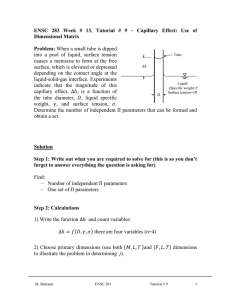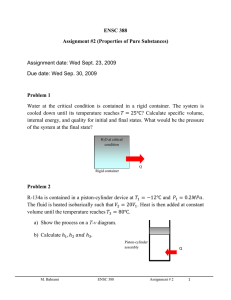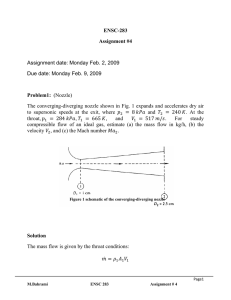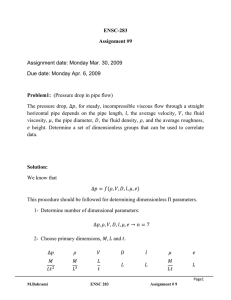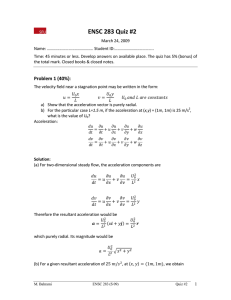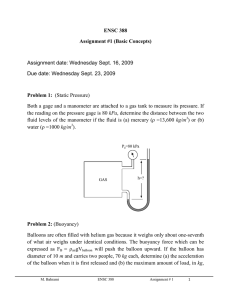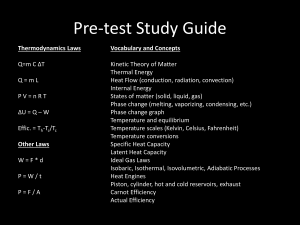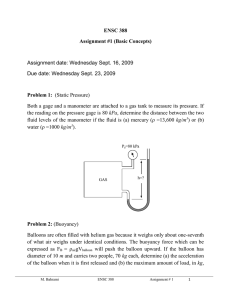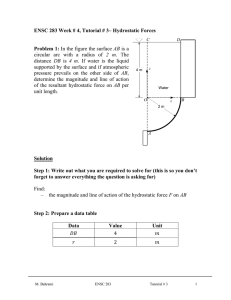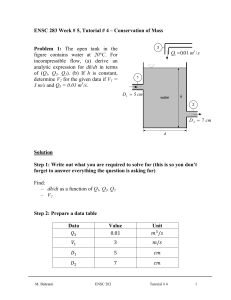The First Law of Thermodynamics: Closed Systems
advertisement
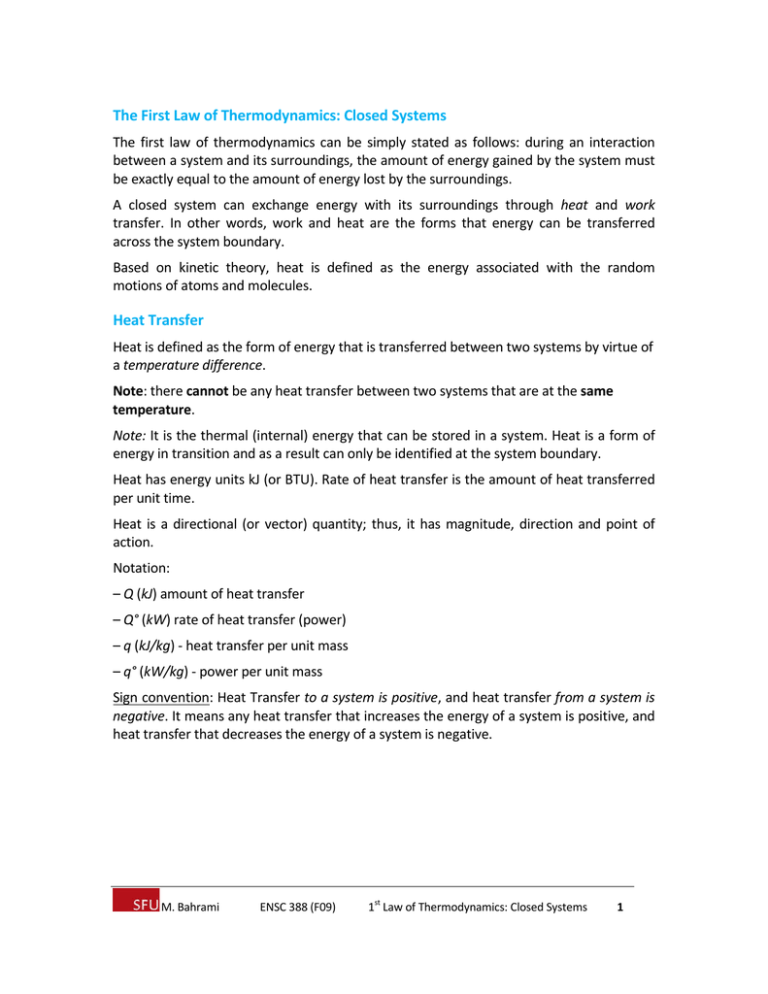
The First Law of Thermodynamics: Closed Systems The first law of thermodynamics can be simply stated as follows: during an interaction between a system and its surroundings, the amount of energy gained by the system must be exactly equal to the amount of energy lost by the surroundings. A closed system can exchange energy with its surroundings through heat and work transfer. In other words, work and heat are the forms that energy can be transferred across the system boundary. Based on kinetic theory, heat is defined as the energy associated with the random motions of atoms and molecules. Heat Transfer Heat is defined as the form of energy that is transferred between two systems by virtue of a temperature difference. Note: there cannot be any heat transfer between two systems that are at the same temperature. Note: It is the thermal (internal) energy that can be stored in a system. Heat is a form of energy in transition and as a result can only be identified at the system boundary. Heat has energy units kJ (or BTU). Rate of heat transfer is the amount of heat transferred per unit time. Heat is a directional (or vector) quantity; thus, it has magnitude, direction and point of action. Notation: – Q (kJ) amount of heat transfer – Q° (kW) rate of heat transfer (power) – q (kJ/kg) ‐ heat transfer per unit mass – q° (kW/kg) ‐ power per unit mass Sign convention: Heat Transfer to a system is positive, and heat transfer from a system is negative. It means any heat transfer that increases the energy of a system is positive, and heat transfer that decreases the energy of a system is negative. st M. Bahrami ENSC 388 (F09) 1 Law of Thermodynamics: Closed Systems 1 System Heat out Heat in Q = ‐ 5 kJ Q = 5 kJ Fig. 1: Sign convention: positive if to the system, negative if from the system. Modes of Heat Transfer Heat can be transferred in three different modes conduction, convection, and radiation. All modes of heat transfer require the existence of a temperature difference. Conduction: is the transfer of energy from the more energetic particles to the adjacent less energetic particles as a result of interactions between particles. In solids, conduction is due to the combination of vibrations of the molecules in a lattice and the energy transport by free electrons. Convection: is the mode of energy transfer between a solid surface and the adjacent liquid or gas which is in motion, and it involves the combined effects of conduction and fluid motion (advection). Convection is called forced if the fluid is forced to flow by external means such as a fan or a pump. It is called free or natural if the fluid motion is caused by buoyancy forces that are induced by density differences due to the temperature variation in a fluid. Radiation: is the energy emitted by matter in the form of electromagnetic waves (or photons) as a result of the changes in the electronic configurations of the atoms or molecules. Work Work is the energy interaction between a system and its surroundings. More specifically, work is the energy transfer associated with force acting through a distance. Notation: – W (kJ) amount of work transfer – W° (kW) power st M. Bahrami ENSC 388 (F09) 1 Law of Thermodynamics: Closed Systems 2 – w (kJ/kg) ‐ work per unit mass – w° (kW/kg) ‐ power per unit mass Sign convention: work done by a system is positive, and the work done on a system is negative. (‐) Q (+) System (+) (‐) W Fig. 2: Sign convention for heat and work. Similarities between work and heat transfer: Both are recognized at the boundaries of the system as they cross them (boundary phenomena). Systems posses energy, but not heat or work (transfer phenomena). Both are associated with a process, not a state. Heat or work has no meaning at a state. Both are path functions, their magnitudes depend on the path followed during a process as well as the end states. Path functions: have inexact differentials designated by symbol δ. Properties, on the other hand, are point functions which depend on the state only (not on how a system reaches that state), and they have exact differentials. 2 dV V V1 V 2 (Point function) 1 2 W W 12 (Path function, not W nor W2 - W1 ) 1 Electrical Work The work that is done on a system by electrons. When N coulombs of electrons move through a potential difference V, the electrical work done is: st M. Bahrami ENSC 388 (F09) 1 Law of Thermodynamics: Closed Systems 3 We VN (kJ ) Which can be explained in the rate form as We VI (kW ) Example 1: Electrical work A well‐insulated electrical oven is being heated through its heating element. Determine whether it is work or heat interaction. Consider two systems: a) the entire oven (including the heater), and b) only the air in the oven (without the heater) see Fig 3‐3. Solution: The energy content of the oven is increased during this process. a) The energy transfer to the oven is not caused by a temperature difference between the oven and air. Instead, it is caused by electrical energy crossing the system boundary and thus: this is a work transfer process. b) This time, the system boundary includes the outer surface of the heater and will not cut through it. Therefore, no electrons will be crossing the system boundary. Instead, the energy transfer is a result of a temperature difference between the electrical heater and air, thus: this is a heat transfer process. Electric oven Electric oven air air Heater Heater System boundary System boundary Fig. 3: Schematic for example 1. Mechanical work There are several ways of doing work, each in some way related to a force acting through a distance. W F .s st M. Bahrami ENSC 388 (F09) 1 (kJ ) Law of Thermodynamics: Closed Systems 4 If the force is not constant, we need to integrate: 2 W F .ds (kJ ) 1 There are two requirements for a work interaction: there must be a force acting on the boundary the boundary must move Therefore, the displacement of the boundary without any force to oppose or drive this motion (such as expansion of a gas into evacuated space) is not a work interaction, W=0. Also, if there are no displacements of the boundary, even if an acting force exists, there will be no work transfer W = 0 (such as increasing gas pressure in a rigid tank). Moving Boundary Work The expansion and compression work is often called moving boundary work, or simply boundary work. We analyze the moving boundary work for a quasi‐equilibrium process. Consider the gas enclosed in a piston‐cylinder at initial P and V. If the piston is allowed to move a distance ds in a quasi‐equilibrium manner, the differential work is: Wb F .ds PAds PdV The quasi‐equilibrium expansion process is shown in Fig. 4. On this diagram, the differential area dA under the process curve in P‐V diagram is equal to PdV, which is the differential work. Note: a gas can follow several different paths from state 1 to 2, and each path will have a different area underneath it (work is path dependent). The net work or cycle work is shown in Fig. 5. In a cycle, the net change for any properties (point functions or exact differentials) is zero. However, the net work and heat transfer depend on the cycle path. ΔU = ΔP = ΔT = Δ(any property) = 0 for a cycle st M. Bahrami ENSC 388 (F09) 1 Law of Thermodynamics: Closed Systems 5 Fig. 4: the area under P‐V diagram represents the boundary work. P 2 Wnet 1 V2 V1 V Fig. 5: network done during a cycle. Polytropic Process During expansion and compression processes of real gases, pressure and volume are often related by PVn=C, where n and C are constants. The moving work for a polytropic process can be found: 2 2 1 1 W polytopic PdV CV n dV P2V2 P1V1 1 n Since P1V1n P2V2n C . For an ideal gas (PV= mRT) it becomes: st M. Bahrami ENSC 388 (F09) 1 Law of Thermodynamics: Closed Systems 6 W polytropic mR T2 T1 , n 1 (kJ ) 1 n The special case n =1 is the isothermal expansion P1V1 = P2V2 = mRT0= C, which can be found from: 2 2 V C Wb ,isothermal PdV dV P1V1 ln 2 V V1 1 1 , n 1 (kJ ) Since for an ideal gas, PV=mRT0 at constant temperature T0, or P=C/V. Example 2: Polytropic work A gas in piston‐cylinder assembly undergoes a polytropic expansion. The initial pressure is 3 bar, the initial volume is 0.1 m3, and the final volume is 0.2 m3. Determine the work for the process, in kJ, if a) n=1.5, b) n=1.0, and c) n=0. Solution: Assume that i) the gas is a closed system, ii) the moving boundary is only work mode, and iii) the expansion is polytropic. a) n =1.5 V2 W PdV V1 P2V2 P1V1 1 n We need P2 that can be found from P1V1n P2V2n : V P2 P1 1 V2 n 0.1 3bar 0.2 1.5 1.06bar 0.2m 3 30.1 10 5 N / m 2 W 1 1 .5 1 bar 1.06 bar 1 kJ 3 17.6 kJ 10 N .m b) n =1, the pressure volume relationship is PV = constant. The work is: 2 V W PdV P1V1 ln 2 V1 1 5 2 0.2 3 10 N / m 1 kJ W 3bar 0.1 m ln 20.79 kJ 3 1 bar 10 N .m 0.1 c) For n = 0, the pressure‐volume relation reduces to P=constant (isobaric process) and the integral become W= P (V2‐V1). Substituting values and converting units as above, W=30 kJ. st M. Bahrami ENSC 388 (F09) 1 Law of Thermodynamics: Closed Systems 7 Spring work For linear elastic springs, the displacement x is proportional to the force applied: F ks x where ks is the spring constant and has the unit kN/m. The displacement x is measured from the undisturbed position of the spring. The spring work is: Wspring 1 k s x 22 x12 2 (kJ ) Note: the work done on a spring equals the energy stored in the spring. Non‐mechanical forms of work Non‐mechanical forms of work can be treated in a similar manner to mechanical work. Specify a generalized force F acting in the direction of a generalized displacement x, the work transfer associated with the displacement dx is: W F .dx Example 3: Mechanical work Calculate the work transfer in the following process: P 2 P2 P1 1 3 V1 V2 V Fig. 6: Schematic P‐V diagram for Example 3. Solution: Process 1‐2 is an expansion (V2 > V1) and the system is doing work (W12 >0), thus: W12 = P1 (V2 ‐ V1) + [0.5(P1+P2) – P1] (V2 – V1) = (V2 – V1) (P1 + P2) / 2 Process 2 ‐ 3 is an isometric process (constant volume V3 = V2), so W23 = 0 Process 3 ‐ 1 is a compression (V3 > V1), work is done on the system, (W31< 0) st M. Bahrami ENSC 388 (F09) 1 Law of Thermodynamics: Closed Systems 8 W31 = ‐ P1 (V2 – V1) Wcycle = Wnet = W12 + W23 + W31 = (V2 – V1) (P2 – P1) / 2 Note that in a cycle ΔU = ΔP = ΔT = Δ(any property) = 0 First Law of Thermodynamics First law, or the conservation of energy principle, states that energy can be neither created nor destroyed; it can only change forms. The first law cannot be proved mathematically, it is based on experimental observations, i.e., there are no process in the nature that violates the first law. The first law for a closed system or a fixed mass may be expressed as: net energy transfer to (or from) = net increase (or decrease) in the total the system as heat and work energy of the system Q – W = ΔE (kJ) where Q = net heat transfer (=ΣQin – ΣQout) W= net work done in all forms (=ΣWin – ΣWout) ΔE= net change in total energy (= E2 – E1) The change in total energy of a system during a process can be expressed as the sum of the changes in its internal, kinetic, and potential energies: ΔE= ΔU + ΔKE + ΔPE (kJ) U m u 2 u1 1 m V22 V12 2 PE mg z 2 z1 KE Note: for stationary systems ΔPE=ΔKE=0, the first law reduces to Q – W = ΔU The first law can be written on a unit‐mass basis: q – w = Δe (kJ/kg) or in differential form: δQ – δW = dU (kJ) δq – δW = du (kJ/kg) or in the rate form: st M. Bahrami ENSC 388 (F09) 1 Law of Thermodynamics: Closed Systems 9 Q° – W° = dE / dt (kW) For a cyclic process, the initial and final states are identical, thus ΔE=0. The first law becomes: Q – W = 0 (kJ) Note: from the first law point of view, there is no difference between heat transfer and work, they are both energy interactions. But from the second law point of view, heat and work are very different. Example 4: Fist law Air is contained in a vertical piston‐cylinder assembly fitted with an electrical resistor. The atmospheric pressure is 100 kPa and piston has a mass of 50 kg and a face area of 0.1 m2. Electric current passes through the resistor, and the volume of air slowly increases by 0.045 m3. The mass of the air is 0.3 kg and its specific energy increases by 42.2 kJ/kg. Assume the assembly (including the piston) is insulated and neglect the friction between the cylinder and piston, g = 9.8 m/s2. Determine the heat transfer from the resistor to air for a system consisting a) the air alone, b) the air and the piston. System boundary Piston Piston part a System boundary part b Air Air Fig. 7: Schematic for problem 4. Assumptions: Two closed systems are under consideration, as shown in schematic. The only heat transfer is from the resistor to the air. ΔKE = ΔPE= 0 (for air) The internal energy of the piston is not affected by the heat transfer. a) Taking the air as the system, (ΔKE + ΔPE + ΔU)air = Q – W st M. Bahrami ENSC 388 (F09) 1 Law of Thermodynamics: Closed Systems 10 Q = W + ΔUair For this system work is done at the bottom of the piston. The work done by the system is (at constant pressure): V2 W PdV PV 2 V1 V1 The pressure acting on the air can be found from: PApiston = mpiston g + Patm Apiston P mpiston g Apiston Patm 50kg 9.81m / s 2 P 0.1m 2 1Pa 1kPa 100kPa 104.91 kPa 2 1N / m 1000 Pa Thus, the work is W = (104.91 kPa)(0.045m3) = 4.721 kJ With ΔUair = mair Δuair, the heat transfer is Q = W + mair Δuair = 4.721 kJ + (0.3 kg)(42.2 kJ/kg) = 17.38 kJ b) system consisting the air and the piston. The first law becomes: (ΔKE + ΔPE + ΔU)air + (ΔKE + ΔPE + ΔU)piston = Q – W where (ΔKE = ΔPE)air = 0 and (ΔKE = ΔU)piston= 0. Thus, it simplifies to: (ΔU)air + (ΔPE)piston = Q – W For this system, work is done at the top of the piston and pressure is the atmospheric pressure. The work becomes W = Patm ΔV = (100 kPa)(0.045m3) = 4.5 kJ The elevation change required to evaluate the potential energy change of the piston can be found from the volume change: Δz = ΔV / Apiston = 0.045 m3/ 0.1 m2 = 0.45 m (ΔPE)piston = m piston g Δz = (50 kg)(9.81 m/s2)(0.45 m) = 220.73 J = 0.221 kJ Q = W + (ΔPE)piston + mair Δuair Q = 4.5 kJ + 0.221 kJ + (0.3 kg)(42.2 kJ/kg) = 17.38 kJ Note that the heat transfer is identical in both systems. st M. Bahrami ENSC 388 (F09) 1 Law of Thermodynamics: Closed Systems 11 Specific Heats The specific heat is defined as the energy required to raise the temperature of a unit mass of a substance by one degree. There are two kinds of specific heats: specific heat at constant volume, Cv (the energy required when the volume is maintained constant) specific heat at constant pressure, Cp (the energy required when the pressure is maintained constant) The specific heat at constant pressure Cp is always higher than Cv because at constant pressure the system is allowed to expand and energy for this expansion must also be supplied to the system. Let’s consider a stationary closed system undergoing a constant‐volume process (wb = 0). Applying the first law in the differential form: δq – δw = du at constant volume (no work) and by using the definition of Cv, one can write: C v dT du or u Cv T v Similarly, an expression for the specific heat at constant pressure Cp can be found. From the first law, for a constant pressure process (wb + Δu = Δh). It yields: h Cp T p specific heats (both Cv and Cp) are properties and therefore independent of the type of processes. Cv is related to the changes in internal energy u, and Cp to the changes in enthalpy, h. It would be more appropriate to define: Cv is the change in specific internal energy per unit change in temperature at constant volume. Cp is the change in specific enthalpy per unit change in temperature at constant pressure. Specific heats for ideal gases It has been shown mathematically and experimentally that the internal energy is a function of temperature only. u = u(T) st M. Bahrami ENSC 388 (F09) 1 Law of Thermodynamics: Closed Systems 12 Using the definition of enthalpy (h = u + Pv) and the ideal gas equation of state (Pv = RT), we have: h = u + RT Since R is a constant and u is a function of T only: h = h(T) Therefore, at a given temperature, u, h, Cv and Cp of an ideal gas will have fixed values regardless of the specific volume or pressure. For an ideal gas, we have: du C v T dT dh C p T dT The changes in internal energy or enthalpy for an ideal gas during a process are determined by integrating: 2 u u 2 u1 C v T dT (kJ / kg ) 1 2 h h2 h1 C p T dT (kJ / kg ) 1 As low pressures, all real gases approach ideal‐gas behavior, and therefore their specific heats depend on temperature only. The specific heats of real gases at low pressures are called ideal‐gas specific heats (or zero‐pressure specific heats) and are often denoted by Cp0 and Cv0. To carry out the above integrations, we need to know Cv(T ) and Cp(T ). These are available from a variety of sources: Table A‐2a: for various materials at a fixed temperature of T = 300 K Table A‐2b: various gases over a range of temperatures 250 ≤ T ≤ 1000 K Table A‐2c: various common gases in the form of a third order polynomial For an ideal gas, we can write: RT hT u T dh du R dT dT R C p Cv The ratio of specific heats is called the specific heat ratio k = Cp/Cv: varies with temperature, but this variation is very mild. for monatomic gases, its value is essentially constant at 1.67. Many diatomic gases, including air, have a specific heat ratio of about 1.4 at room temperature. st M. Bahrami ENSC 388 (F09) 1 Law of Thermodynamics: Closed Systems 13 Specific heats for solids and liquids A substance whose specific volume (or density) is constant is called incompressible substance. The specific volumes of solids and liquids (which can be assumed as incompressible substances) essentially remain constant during a process. The constant volume assumption means that the volume work (boundary work) is negligible compared with other forms of energy. As a result, it can be shown that the constant‐volume and constant‐pressure specific heats are identical for incompressible substances: Cp = Cv = C Specific heats of incompressible substances are only a function of temperature, C = C(T) The change of internal energy between state 1 and 2 can be obtained by integration: 2 u u 2 u1 C T dT (kJ / kg ) 1 For small temperature intervals, a C at averaged temperature can be used and treated as a constant, yielding: u C ave T2 T1 The enthalpy change of incompressible substance can be determined from the definition of enthalpy (h = u + Pv) h2 – h1 = (u2 – u1) + v(P2 – P1) Δh = Δu + vΔP (kJ/kg) The term vΔP is often small and can be neglected, so Δh = Δu. Example 5: Specific heat and first law Two tanks are connected by a valve. One tank contains 2 kg of CO2 at 77°C and 0.7 bar. The other tank has 8 kg of the same gas at 27°C and 1.2 bar. The valve is opened and gases are allowed to mix while receiving energy by heat transfer from the surroundings. The final equilibrium temperature is 42°C. Using ideal gas model, determine a) the final equilibrium pressure b) the heat transfer for the process. Assumptions: The total amount of CO2 remains constant (closed system). Ideal gas with constant Cv. The initial and final states in the tanks are equilibrium. No work transfer. st M. Bahrami ENSC 388 (F09) 1 Law of Thermodynamics: Closed Systems 14 CO2 CO2 8 kg, 27C, 1.2 bar 2 kg, 77C, 0.7 bar Valve The final pressure can be found from ideal gas equation of state: Pf mt RT f V1 V2 m1 m2 RT f V1 V2 For tank 1 and 2, we can write: V1 = m1RT1/P1 and V2 = m2RT2/P2. Thus, the final pressure, Pf becomes: m1 m2 RT f Pf m1 m2 T f m1 RT1 m2 RT2 m1T1 m2T2 P1 P2 P1 P2 10kg 315K Pf 2kg 350 K 8kg 300 K 1.05bar 0.7bar 1.2bar b) The heat transfer can be found from an energy balance: ΔU = Q – W With W = 0, Q = Uf –Ui where initial internal energy is: Ui= m1 u(T1) + m2 u(T2) The final internal energy is: Uf = (m1 + m2) u(Tf) The energy balance becomes: Q = m1 [u(Tf) – u(T1)] + m2 [u(Tf) – u(T2)] Since the specific heat Cv is constant Q = m1 Cv [Tf – T1] + m2 Cv [Tf – T2] kJ kJ 315K 350 K 8kg 0.745 315K 300 K 37.25kJ Q 2kg 0.745 kg.K kg.K The plus sign indicates that the heat transfer is into the system. st M. Bahrami ENSC 388 (F09) 1 Law of Thermodynamics: Closed Systems 15
